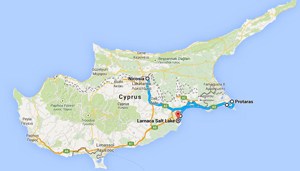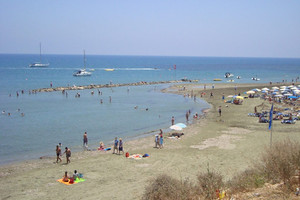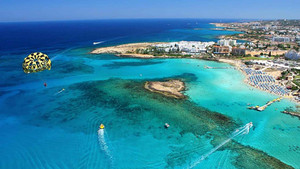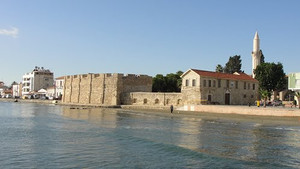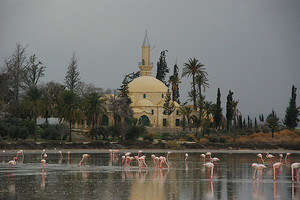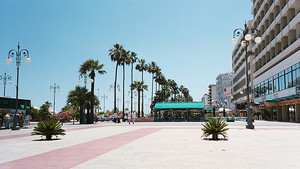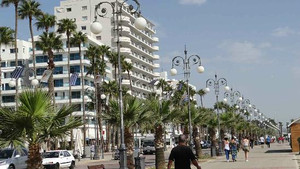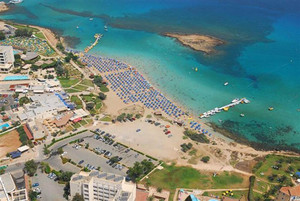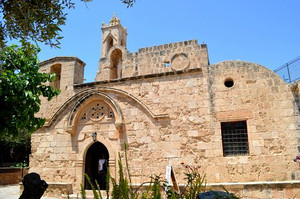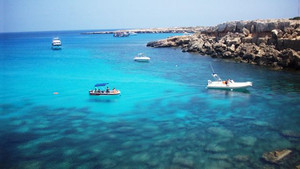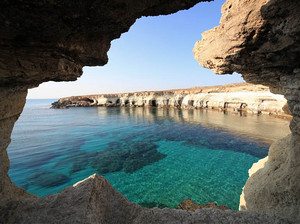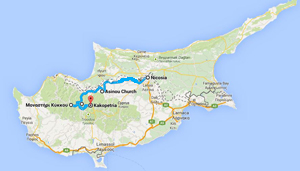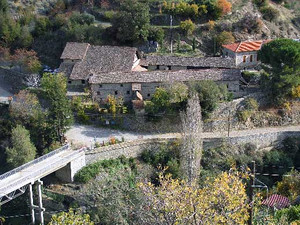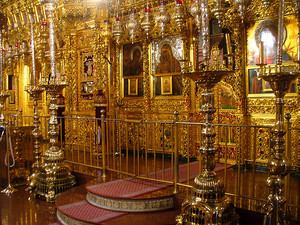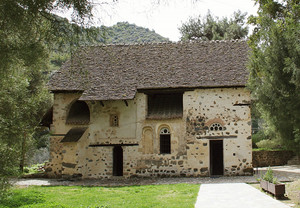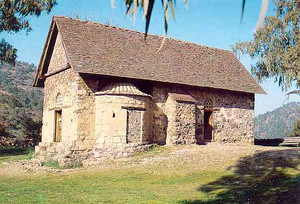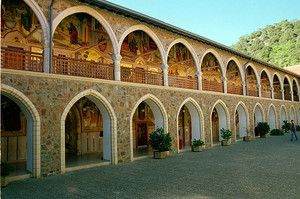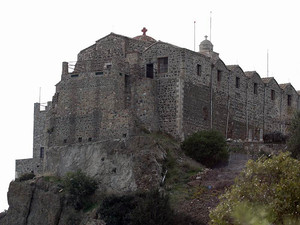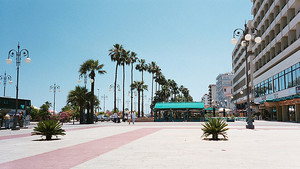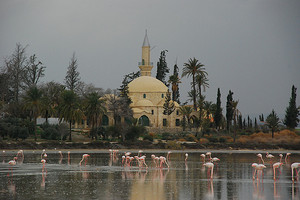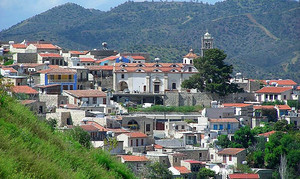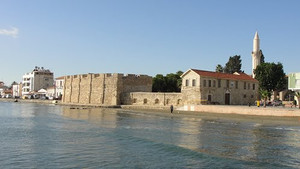Language:
EXCURSIONS FROM NICOSIA
TOUR 1: DISCOVER CYPRUS COAST
(Includes: Ayia Napa, Cape Greco, Sea Caves, Protaras, Fig Tree Bay,Profitis Ilias Church, Larnaca Salt Lake, Makenzy area, Palm tree beach, St. Lazarus church)
Starting from the Cyprus capital and business centre we will be heading straight away to Ayia Napa and the city center. This charming medieval monastery dedicated to ”Our Lady of the Forests” stands in the middle of the village of Agia Napa surrounded by a high wall. Next up is the Cape Greco. It lies between the towns of Ayia Napa and Protaras, both of which are popular tourist resorts. From the high points on the cliff that rests at the cape one can view amazing sights out to sea. The amazing sea caves! The rocky seabed and underwater caves encourage a wealth of sealife making this area a hotspot for both snorkelling and scuba diving. Fishing is also a popular and peaceful way to spend time here. Protaras golden sandy beaches. Beyond a small rocky cove, lies Fig Tree Bay, so-called after some ancient fig trees that once grew here. Fig Tree Beach is considered one of the premiere beaches on Cyprus. Next stop Profitis Ilias Church! On the outskirts of Protaras is a small attractive stone church set atop a rocky crag – the Church of Ayios Ilias. It is well worth a walk to the church and the climb to the top. From the top there is a panoramic view of Protaras and the surrounding countryside. Following the road to Larnaca we will visit the Salt Lake. Besides its picturesque beauty, the lake is the haunt of 85 species of water-birds. It is one of the important migratory passages through Cyprus. Among them are 2,000–12,000 flamingoes which spend the winter months there feeding off populations of the brine shrimp. Finally, Larnaca! Makenzy area and Palm tree beach are the main beach attractions for the tourist. Have a lunch at the nicest fish taverns or use your time to walk along the sandy beaches of Larnaca. A must will be a visit to St. Lazarus church! The splendid church in the center of the town dedicated to its patron Saint Lazarus, constitutes an important center of ecclesiastical worship in the town of Larnaka.
There will be time for you to shop and have lunch. We are looking forward to welcoming you in one of our cars. The tour can be customized so you can suggest places to add or remove from the excursion. The duration of the excursions is 8 hours but you can if you want request a shorter version.
There will be time for you to shop and have lunch. We are looking forward to welcoming you in one of our cars. The tour can be customized so you can suggest places to add or remove from the excursion. The duration of the excursions is 8 hours but you can if you want request a shorter version.
TOUR 2: DISCOVER CYPRUS CHURCHES
(Includes: Asinou Church, Agios Ionannis Lambadistis, Kykkos Monastery, Agios Nicolaos Steghs, Kakopetria)
Starting from the Cyprus capital and business centre we will be heading straight away to Asinou . The famous Byzantine church of Asinou, a UNESCO World Heritage site, has some of the finest examples of Byzantine wall painting on the island. Asinou comes from the Greek Asine, which is an ancient city founded by immigrants from the Greek city Argolis in the 11th century BC. The church dates to the early 12th century and the murals inside date from the 12th century to the 17th century. Moving on from Asinou we will follow a route that will take us to another unique church. The beautiful large monastery of Agios Ioannis Lampadistou stands across the valley and contains one of the ten painted churches of the Byzantine period that are found in the Troodos that are on the UNESCO World Heritage list. Next destination will be the famous Monastery of Kykkos. The monastery is dedicated to the Virgin Mary and is home to one of the three surviving icons painted by the Apostle Luke. Founded in AD 1100 by the Byzantine emperor Alexios Komnenos, Kykkos Monastery is ornately decorated and covered in a silver gilt, enclosed in a tortoiseshell shrine. It is also famous for its museum, located within the monastery grounds, which houses an impressive collection of icons, woodcarvings and manuscripts, and other Cypriot antiquities. Kykkos Monastery is situated in the Troodos which is the biggest mountain range of Cyprus, located in the center of the island. Troodos’ highest peak is Mount Olympus at 1,952 metres, they are home to nine Byzantine churches, included on UNESCO’s World Heritage List, and richly decorated with murals and Byzantine paintings. Leaving the Monastery of Kykkos we will be following a forest route towards the church of Agios Nikolaos Stegis which is located close to the village of kakopetria. The church is completely painted with murals, with the most famous being the fresco of the Virgin Mary breastfeeding the baby Jesus, dating from the 11th to the 17th centuries and is considered one of the most interesting Byzantine churches on the island and boasts he most enchanting setting. Its name refers to the steep, pitched timber roof that was added in the 15th century to protect it from the heavy snowfall, setting the distinctive trend for Troodos chapels. Last destination will be the traditional village of Kakopetria. Kakopetria is a Town in Cyprus located 55 kilometers southwest of the capital, Nicosia, on the north facing foothills of the Troodos Mountains. It stands at an altitude of 667 metres and it is the highest village in the Solea Valley. The community has about 1,200 permanent inhabitants and a couple hundred more who either have a summer house or are originally from kakopetria but work in Nicosia. It is surrounded by thick forestland and is built on the banks of the Kargotis and Garillis Rivers. The two rivers join within village itself and form the river Klarios, which crosses the Solea Valley and empties into Morphou Bay. At Kakopetria you will have the chance to taste Cyprus cuisine as is the place we suggest to have a lunch before starting our way back to Nicosia.
There will be time for you to shop and have lunch.We are looking forward to welcoming you in one of our cars. The tour can be customized so you can suggest places to add or remove from the excursion. The duration of the excursions is 8 hours but you can if you want request a shorter version.
There will be time for you to shop and have lunch.We are looking forward to welcoming you in one of our cars. The tour can be customized so you can suggest places to add or remove from the excursion. The duration of the excursions is 8 hours but you can if you want request a shorter version.
TOUR 3: FROM CAPITAL TO LARNACA
(Includes: Stavrovouni Mountains, Lefkara Village, Kiti Village, Larnaca Salt lake, Larnaca, Makenzy area, Palm Tree Beach,St. Lazarus church)
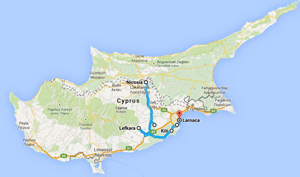
Show the Route in a Larger Map
Starting from the Cyprus capital and business centre we will be heading straight away to Stavrovouni Mountains. There you will find yourself at the monastery is located on the peak of the mountain of the same name (Stavrovouni) in the District of Larnaca. Unfortunately only men are allowed to enter but is a magnificent sightseeing for everybody. Next destination will be the village of Lefkara. Lefkarais a village on the island of Cyprus famous for its lace, known as lefkaritika in and silver handicrafts. Kiti village will be our third but not least sightseeing. At the nearby Kiti village west of Larnaka it’s the small, but very significant stone build church of “Angeloktisti” meaning the church built by the Angels. This is one of the very few early Byzantine monuments that survived on the island with mosaics of the 6th century AD. Following the road to Larnaca we will visit the Salt Lake. Besides its picturesque beauty, the lake is the haunt of 85 species of water-birds. It is one of the important migratory passages through Cyprus. Among them are 2,000–12,000 flamingoes which spend the winter months there feeding off populations of the brine shrimp. Finally, Larnaca! Makenzy area and Palm tree beach are the main beach attractions for the tourist. Have a lunch at the nicest fish taverns or use your time to walk along the sandy beaches of Larnaca. A must will be a visit to St. Lazarus church! The splendid church in the center of the town dedicated to its patron Saint Lazarus, constitutes an important center of ecclesiastical worship in the town of Larnaka.
There will be time for you to shop and have lunch.We are looking forward to welcoming you in one of our cars. The tour can be customized so you can suggest places to add or remove from the excursion. The duration of the excursions is 8 hours but you can if you want request a shorter version.
There will be time for you to shop and have lunch.We are looking forward to welcoming you in one of our cars. The tour can be customized so you can suggest places to add or remove from the excursion. The duration of the excursions is 8 hours but you can if you want request a shorter version.




